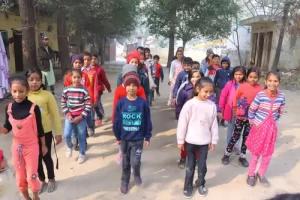The Importance of Girl Child Education and the Government Initiatives in India

The Importance of Girl Child Education and the Government Initiatives in India

Education is a fundamental right of every child, regardless of gender, caste, religion, or socio-economic status. It empowers children to develop their potential and contribute to the development of their society. Education also enables children to acquire life skills, such as critical thinking, communication, problem-solving, and decision-making, essential for their personal and professional growth.
However, in India, millions of girls are denied their right to education due to various barriers, such as poverty, gender discrimination, child marriage, violence, and lack of infrastructure and quality teachers. According to the 2011 census, the literacy rate of females in India was 65.46%, compared to 82.14% for males, with a gender gap in literacy of 16.68 percentage points, indicating a wide disparity in educational opportunities and outcomes for girls and boys.
The lack of education for girls has serious consequences for their health, well-being, and future prospects. Uneducated girls are more likely to marry early, have more children, face domestic violence, and suffer from malnutrition and diseases. They are also less likely to participate in the economic, social, and political spheres of their society, and have less voice and agency in their own lives.
Therefore, it is imperative to promote girl child education in India, not only as a matter of justice and equality but also as a key driver of development and progress. Educating girls can transform their lives, as well as the lives of their families, communities, and countries. Educated girls are more likely to delay marriage and childbirth, have fewer and healthier children, earn higher incomes, and invest in their children’s education. They can also challenge gender stereotypes and norms, becoming leaders and agents of change in their society.
Top Five Education Schemes for Girl Child in India
Beti Bachao Beti Padhao (BBBP) Scheme:
- Launched in 2015, Beti Bachao Beti Padhao (Save the Girl Child, Educate the Girl Child) is a flagship scheme aimed at addressing the declining child sex ratio and promoting the education of the girl child. The scheme focuses on districts with a low child sex ratio, providing financial assistance for the education and health of the girl child. Implemented in a convergent and collaborative manner with the State Governments/UTs and other relevant Ministries/Departments and stakeholders, the scheme has several components, including creating awareness and public mobilization, strengthening the function and delivery of ICDS, strengthening schools and education, and enabling girls’ education.
Sukanya Samriddhi Yojana (SSY):
- Launched in 2015, Sukanya Samriddhi Yojana (Girl Child Prosperity Scheme) is a small deposit scheme for the girl child. The scheme allows parents to open a savings account in the name of the girl child and provides a high-interest rate of 7.6%. The money can be withdrawn when the girl child turns 18 for her education or marriage. The scheme is available for girl children below the age of 10 years, and the account can be opened in any post office or authorized bank branch by the legal guardian of the girl child.
Kasturba Gandhi Balika Vidyalaya (KGBV) Scheme:
- Launched in 2004 to provide education to girls from disadvantaged sections of society, this scheme involves setting up residential schools for girls in areas with low female literacy rates. The schools provide education up to the 8th standard and hostel facilities. Aimed at providing educational facilities to girls belonging to Scheduled Castes, Scheduled Tribes, Other Backward Classes, minority communities, and families below the poverty line in difficult areas, the scheme is implemented through the State Governments/UTs, with KGBVs run and managed by them. The scheme provides a one-time grant of Rs. 5 lakhs to set up the school and a recurring grant of Rs. 1.5 lakhs per annum for running the school.
CBSE Udaan Scheme:
- Launched in 2014, the CBSE Udaan Scheme offers mentoring and scholarships for Class 11 and 12 girls pursuing engineering and technology. The scheme offers free coaching, study materials, mock tests, and mentoring to selected girls nationwide. The scheme provides financial aid for tuition and expenses to encourage girl students in engineering colleges.
National Scholarship for Higher Education of ST Girls:
- Launched in 2018, the National Scholarship for ST Girls supports Scheduled Tribe girls pursuing higher education. The scheme offers a scholarship of Rs. 3000 monthly for up to five years or until course completion. The scheme supports ST girl students in pursuing higher education, enhancing their employability and empowerment.
How My Abhinandan NGO Supports Girl Child Education
My Abhinandan is a non-governmental organization (NGO) dedicated to the empowerment of children, women, and the environment in India. One primary focus is girl child education, crucial for breaking poverty and inequality cycles. My Abhinandan NGO supports girl child education through a range of initiatives, including providing scholarships, mentoring, skill development, career guidance, and awareness campaigns.
The Skill Development NGO partners with schools and communities to create a safe environment for girls’ education. My Abhinandan has helped thousands of low-income girls access education and achieve their dreams.
Conclusion